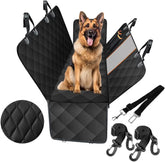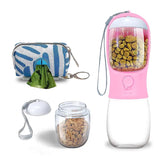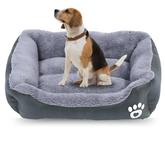Getting a puppy? Get ready for tail wags, snuggles, nose kisses, and nonstop being chased by your furry friend. But between puppy cuddles and playtime, one important task that almost stays forgotten is puppy grooming.
Starting a grooming routine early not only keeps their coat in fantastic shape—it also gets your pup accustomed to being touched, which is a time-saver for both of you down the road. It saves you money on all those trips to the groomer, and—and this is where it gets critical—it builds trust.
When your pet understands that bathing, nail trimming, and brushing are okay and even pleasurable with you, it's a whole lot easier for both you and your animal. As an added bonus, it's one of the greatest bonding experiences and the best way to remind your dog how much you love him.
Importance of Getting Your Puppy Groomed
Dog grooming is all about a heck of a lot more than just cutting puppy hair too soon. It is to ensure your little furry pal is looking good on the outside—grooming is a crucial aspect of his overall health, comfort, and long-term well-being.
Brushing, bathing, and regular trimming keep their fur clean, soft, silky, and tangle- and mat-free. Bathing is a great way to check for any early indication of flea, tick, or skin issues before they occur.
Start slow, remain patient, and you'll make your puppy feel calm and secure when it's time for your puppy’s first grooming experience. You're likely asking yourself when puppies can take a bath. Typically, once they are past 8 weeks of age, their body temperature regulation becomes more stable. Prior to that, brush and wipe-downs are all you need.
By grooming early, you're also developing habits that your puppy will retain throughout their life—making them less anxious and obedient when being groomed later on.
Checklist for Puppy Grooming at Home
Before diving in, here’s what you’ll need in your grooming toolkit:
- Soft dog brushes for grooming
- Gentle puppy shampoo
- Puppy nail clippers or grinder
- Round-tip puppy grooming scissors
- Dog-specific toothpaste and finger brush
- Ear cleaner and cotton pads
- Eye wipes or damp cloth
- Puppy grooming table or non-slip mat
- Towel and low-heat hairdryer
- Treats for positive reinforcement
8 Essential Puppy Grooming Tasks You Can Do at Home
With a couple of tools and a little patience, you can make grooming a bonding experience while keeping your pup happy, healthy, and cute.
1. Brushing Your Puppy’s Coat
Brushing may be the most basic aspect of puppy grooming, but it is truly one of the most vital. Not only will it leave your pup all adorably scrubbed up (which, naturally, is an absolute added plus!), but it's also accountable in large measure for ensuring that they are healthy, inside and out.
Begin with a soft grooming brush appropriate for the puppy coat. Short-haired puppies love the rubber brushes, whereas slicker brush or pin brushes are ideal for long-haired puppies to prevent matting and tangling.
Pro Tip: Groom your puppy only when relaxed—after napping or playtime. Brief and sweet, and reward with treats and praise to create a positive, enjoyable experience. Don't forget. Your puppy will come to associate brushing with cuddle time, not chore time, over time!
2. Bathing Your Puppy
Bath time is a success when you understand how to bathe a puppy the correct way. You don't overdo it—Puppies are not given many baths, but when they do receive a bath, doing it right keeps their coat and skin in top condition.
So, when puppies can take a bath? Generally, after they are older than 8 weeks and have settled into the new environment. Bathing them too soon would stress them out or cause them to get a chill as their immune system is not fully developed.
Always bathe in lukewarm water—not cold, not hot. Cold water will shock them, and hot water will destroy their sensitive skin. Choose a mild puppy shampoo, and do not splash water on their ears, nose, and eyes. Wash the body rather with your hand or a soft cup.
Pat dry carefully after a bath with a soft towel and, if your puppy will hold still, use a low-heat hairdryer on its lowest setting to avoid any chilliness—hold it at arm's length from their skin.
Useful Tip: Minimize stress during the bathing process by gradually acclimatizing them with toys or treats and in a calm voice throughout the procedure.
3. Trimming Puppy’s Nails
Nail trimming is also commonly neglected but plays a key role in puppy grooming at home. Painful nails for your puppy and even affecting their walking or posture can result in long-term joint problems.
Use equipment that is included in a good puppy grooming kit, like specially made nail clippers or an electric grinder. These are made to be safe for small puppy paws.
Trim nails every 2–3 weeks or as soon as you notice them clicking on hard surfaces.
Clip carefully—cut only the curved tip of the nail and avoid clipping too close to the quick (the sensitive edge of the nail that holds nerve and blood supplies).
If your puppy's nails are pale or white, it will be simple to find the quick. With dark nails, clip little bits at a time to avoid hurting.
Quick Tip: Always have styptic powder or cornstarch with you. In case of an accidental cut that leads to bleeding, this will stop it in no time.
4. Cleaning Your Puppy’s Ears
Ear cleaning for dogs is included in regular puppy grooming at home, especially for floppy-eared or hairy-eared puppies. Dirty ears can get infected or inflamed or lead to hearing issues if left untreated.
Apply a vet-recommended ear cleaner and cotton balls. Avoid Q-tips or packing something in the ear canal—it's not healthy. Gently raise the puppy's ear flap and put a few drops of solution in the ear. Massage the ear base to dislodge debris.
Let your dog shake its head in a normal way, then clean the outside of the ear using a soft cloth or cotton plug.
Useful Tip: Move slowly and establish ear cleaning using positive reinforcement and rewards. It builds trust and offers a sounder foundation for future grooming.
5. Trimming the Fur (Face, Paws, Sanitary Areas)
Removing excess fur from sensitive regions such as the face, paws, and bottom helps your puppy feel comfortable, clean, and less susceptible to infections or matting.
Cut with round-tip puppy grooming scissors for safety. They are meant to avoid accidental nicks, particularly when working with restless pups.
Be cautious with cutting puppy hair too soon—wait until they’re at least 12–16 weeks old and have adapted to basic grooming. Target sanitary regions, paw pads, and excessive fur around eyes or mouths. This avoids hygiene problems, maintains eyesight, and prevents material accumulation.
Regular trimming of paw pads in thick-coated varieties also avoids slipping on smooth surfaces.
Pro Tip: Always work in a quiet space with plenty of light. Talk to your pup softly to calm them and offer breaks with treats to make grooming a fun experience.
6. Brushing Teeth
Dental hygiene is often the forgotten part of the puppy grooming routine, but it's an important part of your puppy's overall well-being.
Apply dog toothpaste and a soft finger brush or small dog toothbrush. Brush in small circles, particularly along the gum line, where food and plaque will congregate.
2–3 brushings per week is the best solution for keeping oral hygiene for puppies.
Gradually introduce your puppy to brushing—have them lick the toothpaste first, then gradually introduce gentle brushing over several sessions.
Quick Tip: Introduce dental care early so your pup will grow up with it as a routine task, rather than a stressful one.
7. Cleaning Eye Area
Some puppies, particularly those with short noses or light-colored coats such as Pugs or Shih Tzus, are susceptible to puppy tear stains and dirty eye accumulation.
Wipe the eye corners with a damp, soft cloth or pet-friendly eye wipes. This should be a daily routine of face grooming for puppies, if needed, to keep the face clean and avoid bacterial growth.
Always wipe in the direction of the eyes, not towards them. Do not rub too hard.
Tips: Clip the hair around your puppy's eyes with blunt-nosed scissors. It prevents irritation and works to reduce tear stains.
8. Creating a Grooming Area That Is Safe
Prior to beginning any grooming session, establishing a safe and distraction-free environment is important both for safety and convenience.
An ideal puppy grooming table with a non-slip surface is available, but even a stable counter or table that has a non-slip mat will do fine for small dogs.
Ensure that the grooming aids are within arm's reach—the avoidance of turning away and abandoning your puppy comes in handy here. Keep your dog restrained with a grooming arm or loop if necessary (supervised only), and stay calm at all times to prevent scaring them.
A designated grooming area also makes your puppy equate the area with regular grooming and not tension.
Bonus Tip: A dedicated space is faster grooming, more efficient organization, and less clutter around your house.
Wrapping Up Your Puppy’s Grooming Routine
Putting your puppy into a daily grooming routine from the start is one of the best things you can do for your little buddy. It not only keeps your pup clean and healthy, but it also strengthens the relationship between you and your little pal even more. From combing their coats to trimming their nails and wiping their ears clean, it seems like every small detail of grooming is helping them in the long run to feel safe and nurtured.
These easy-to-use products guarantee that at-home puppy grooming is not just possible but a joy for both of you. Develop reminders or a printed-out calendar to routineize grooming time and make it an easy process. Keep all sessions brief and pleasant, and always reward or compliment your pup afterward.
If you don't know how to bathe your pup properly or you're not good with handling grooming instruments. Consult the vet ot professional groomer.















